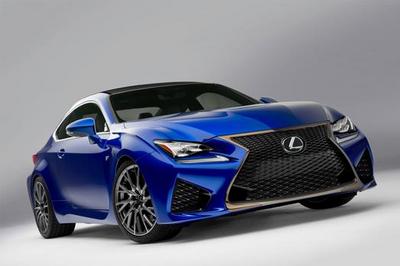Lexus RC F: Engineered For Grip And Agility
 |
EPSOM, UK -- December 9, 2014: Every aspect of the RC F, from its footprint on the road and its body rigidity, to its suspension, brakes, steering and chassis electronics, was designed to achieve the best grip and agile handling.
Right from the prototype stage, the RC F was evaluated on race tracks around the world, including Fuji Speedway (true to the car’s sporting Lexus “F” designation) and the Nürburgring Nordschleife. The chassis development included taking part in the endurance racing events at the Nürburgring, and using feedback from drivers racing the Lexus IS F and CCS-R in Japan.
BODYSHELL RIGIDITY
Although the RC F has relatively compact overall dimensions – 4,705mm long, 1,845mm wide and 1,390mm high – its 2,730mm wheelbase, 1,555mm front track and 1,560mm rear track give it a surprisingly large road footprint, helping maximise the car’s dynamic potential.
The bodyshell follows the example set by the Lexus GS in being particularly strong and rigid, tuned for stability at high speed and promoting ultra-precise handling and steering in all driving conditions.
To increase cabin strength and handling stability, key structural elements have been made more robust and additional reinforcements have been added in key areas.
The way in which the body shell is assembled also plays an important part in overall strength of the coupe, and the reduction of vibration and cabin deformation too, for example the use of body adhesive in panel joints, additional spot welding points and laser screw welding.
Bodyshell weight has been minimised by using high-tensile sheet steel and aluminium in key areas. The bonnet inner and outer skins and the bumper reinforcement are all made of aluminium, while on the RC F Carbon model, the CFPR bonnet, roof and rear wing together reduce overall vehicle weight by 10kg.
PERFORMANCE-TUNED SUSPENSION
The RC F is equipped with double wishbone front and multi-link rear suspension, honed during extensive track testing.
The front suspension features forged aluminium upper and lower arms, to save weight and maximise rigidity. The rear suspension geometry has been defined exclusively for the RC F with a revised geometry and strategic use of aluminium to reduce unsprung weight.
Together these measures ensure outstanding responsiveness, with crisp turn-in and well controlled, progressive body roll, while maintaining the smooth, pliant ride that’s to be expected from even a high-performance Lexus.
ELECTRONIC POWER STEERING
The RC F’s electronic power steering is designed to achieve excellent dynamic performance and steering feel. Intensive testing and calibration of the power assistance curve ensure the steering feel ideally matches the vehicle’s dynamic characteristics, even in track driving.
A damper-less intermediate shaft has been added to the steering column to increase system rigidity and secure a high degree of responsiveness to steering input. The new shaft features an expandable/contractible stroke mechanism to absorb shaft length changes when driving. This gives a smoother steering feel and a reduction in response lag.
NEW BRAKE PACKAGE
The RC F has an all-new Brembo brake package, with improved cooling and a vertical G-sensor integrated in the ABS.
At the front there are 380 x 34mm discs with opposed six-piston aluminium callipers; at the rear the discs measure 345 x 28mm, with opposed four-piston aluminium callipers. Using integrated aluminium monobloc callipers provides high rigidity while also reducing weight.
The ventilated front discs are slotted rather than drilled, helping to keep the brake pads clean and their effectiveness consistent under all driving conditions. The front discs are equipped with spiral fins which, in conjunction with improved cooling duct efficiency, ensure excellent cooling performance.
The adoption of a G-sensor is a direct result of testing at the Nürburgring. It means the system can allow for changes in vertical loads, and hence optimise braking force control the instant load returns to the tyres after jumping a crest.
WHEELS AND TYRES
The RC F runs on 19-inch forged aluminium wheels. Two designs are offered to UK customers: the RC F uses rims with five pairs of double thin spokes, each with a machined finish; the RC F Carbon has wheels with twin sets of 10 spokes, the inner series set 30 degrees ahead of the outer.
Different size tyres are used at the front and rear, respectively 255/35R19 and 275/35R19. A weight-saving tyre repair kit is provided as standard.


